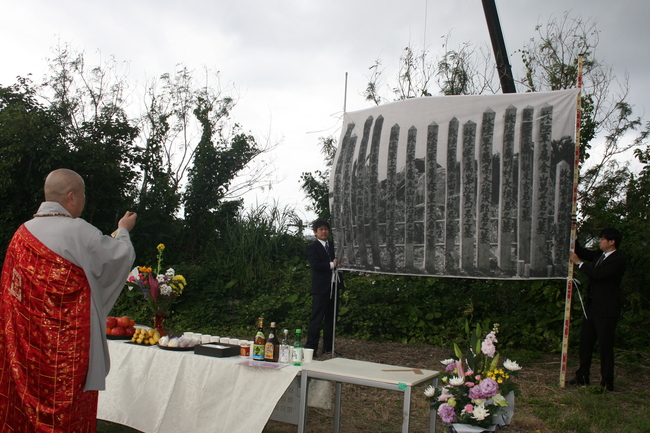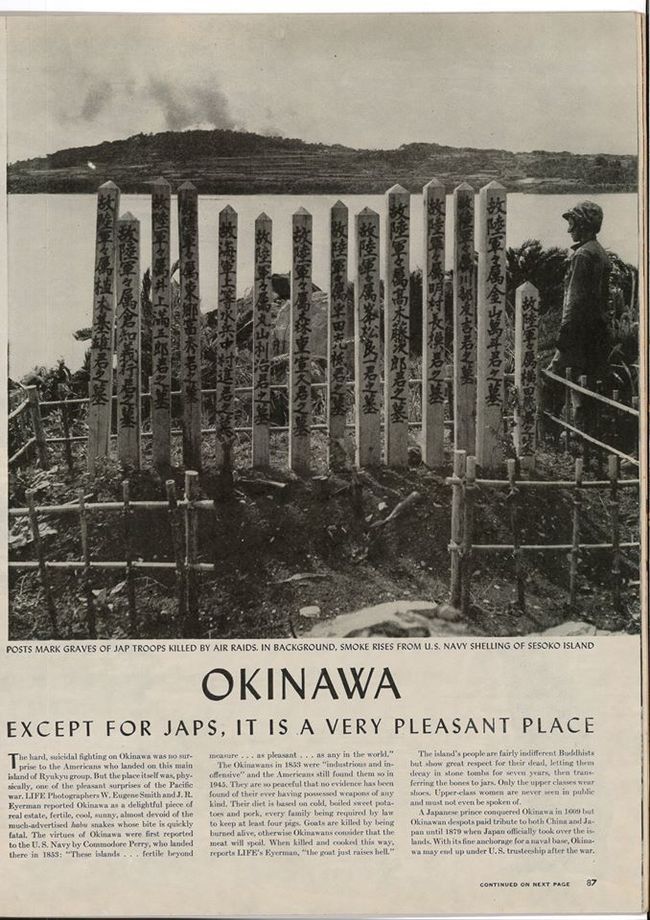Posted on : Feb.18,2019 17:15 KST
 |
|
A memorial ceremony for two Korean victims of the Pacific War at a seaside parking lot in Kenken, part of the Motobu-cho neighborhood of Kunigami County, Okinawa Prefecture, on Feb. 16.
|
Korean workers were forcibly mobilized by Japanese soldiers
“We will have a moment of mourning as we call out the names of each of the victims. Manto Kaneyama, Korean name Kim Man-du. Chomo Meimura, Korean name Myeong Jang-mo.”
A memorial ceremony for two Korean victims of the Pacific War was held on Feb. 16 at a seaside parking lot in Kenken, part of the Motobu-cho neighborhood of Kunigami County in Okinawa Prefecture. The bodies of two Koreans mobilized as civilian workers for the Japanese military are believed to lie buried underneath the facility. Motobu is a noted tourism site that is home to the Churaumi Aquarium, a popular destination for South Koreans. The ceremony was part of a “Joint East Asian Workshop” program organized by the South Korean civic group Steppingstone for Peace and the Japanese civic group East Asia Citizens‘ Network, among others.
 |
|
A photograph in the May 1945 edition of Life magazine depicting a US soldier next to a line of wooden grave markers, two of which bear Japanese names forcibly adopted by Koreans Kim Man-du (second from right) and Myeong Jang-mo (fourth from right).
|
Photo from photo in Life magazine from 1945 offered clue
The reason the two Koreans are believed to be buried here has to do with a photograph published in May 1945 in the magazine Life. In the image, a US soldier looks at the sea next to a line of wooden grave markers. Two of the 14 markers bear names that are unlikely to have belonged to native Japanese people. Could “Manto Kaneyama” and “Chomo Meimura” have been Japanese names forcibly adopted by two Koreans? By examining a list of forcibly mobilized Koreans, Okinawa civic activists were able to confirm that the two were Koreans mobilized as civilian workers for the Japanese army. Since the story was shared in 2017 by the local newspaper Ryukyu Shimpo, South Korean and Japanese groups have begun planning an effort to exhume the remains. The digging is scheduled to begin as early as Jan. 2020.
The owner of the parking lot site, 77-year-old Masanobu Kabe, lent his support to the exhumation.
“My mother told me about a Japanese soldier during the war who kept striking Koreans. She said she had witnessed a Korean being mercilessly beaten,” explained Kabe while attending the memorial ceremony.
“My mother also said she had given sweet potatoes to starving Koreans who had shown up at the house pleading for something to eat. She also told them she had peppers, but that they would be too hot for them to eat, and the Koreans asked her to give them those too,” he recalled.
While Kabe’s father was still alive, he had said that no house could be built on the land because there were bodies buried underneath. Even today, residents rarely park their cars in the lot where bodies are believed to lie buried, he added. Indeed, the grass growing on the unpaved lot seemed to suggest that not many people parked their vehicles there.
Japanese military records share information about how Kim and Myeong lost their lives. Both were killed on Jan. 22, 1945, while traveling on a supply ship that was attacked by US forces. At the time, the US military was conducting air raids all over the island ahead of a landing operation. Resident Hideo Nakamura, who lives across from the parking lot to this day, told civic groups about a site where Japanese soldiers buried bodies after burning them. Once the remains are exhumed, DNA testing could confirm whether any of them belong to Koreans.
Over 200,000 Japanese soldiers, Okinawa residents, and mobilized Koreans and Taiwanese are believed to have died in Okinawa during the Pacific War. For the most part, the fate of the Koreans‘ remains is impossible to even guess. Kim and Myeong represent a special case in that regard.
“Underneath the soil we are standing on, the bodies of two Koreans and other civilian Japanese military workers may lie buried,” said Fukiko Okimoto, who has researched the topic of the remains of Koreans on Okinawa for many years.
“There may still be many bodies buried in the sea and in the mountains. Okinawa is one enormous tomb,” she said.
By Cho Ki-weon, Tokyo correspondent
Please direct comments or questions to [english@hani.co.kr]










